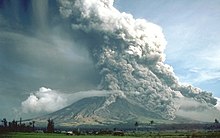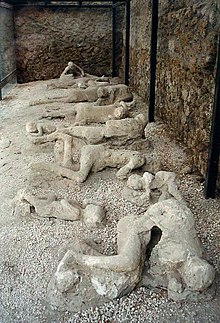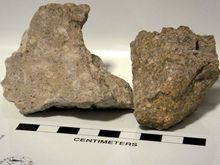Pyroclastic flow

A pyroclastic flow (also known as a pyroclastic density current or a pyroclastic cloud)[1] is a fast-moving current of hot gas and volcanic matter (collectively known as tephra) that flows along the ground away from a volcano at average speeds of 100 km/h (62 mph) but is capable of reaching speeds up to 700 km/h (430 mph).[2] The gases and tephra can reach temperatures of about 1,000 °C (1,830 °F).
Pyroclastic flows are the most deadly of all volcanic hazards[3] and are produced as a result of certain explosive eruptions; they normally touch the ground and hurtle downhill, or spread laterally under gravity. Their speed depends upon the density of the current, the volcanic output rate, and the gradient of the slope.
Origin of term[]
The word pyroclast is derived from the Greek πῦρ, meaning "fire", and κλαστός, meaning "broken in pieces".[4][5] A name for pyroclastic flows which glow red in the dark is nuée ardente (French, "burning cloud"); this was notably used to describe the disastrous 1902 eruption of Mount Pelée on Martinique.[6][note 1]
Pyroclastic flows that contain a much higher proportion of gas to rock are known as "fully dilute pyroclastic density currents" or pyroclastic surges. The lower density sometimes allows them to flow over higher topographic features or water such as ridges, hills, rivers and seas. They may also contain steam, water and rock at less than 250 °C (482 °F); these are called "cold" compared with other flows, although the temperature is still lethally high. Cold pyroclastic surges can occur when the eruption is from a vent under a shallow lake or the sea. Fronts of some pyroclastic density currents are fully dilute; for example, during the eruption of Mount Pelée in 1902, a fully dilute current overwhelmed the city of Saint-Pierre and killed nearly 30,000 people.[7]
A pyroclastic flow is a type of gravity current; in scientific literature they are sometimes abbreviated to PDC (pyroclastic density current).
Causes[]
This section does not cite any sources. (March 2018) |
There are several mechanisms that can produce a pyroclastic flow:
- Fountain collapse of an eruption column from a Plinian eruption (e.g. Mount Vesuvius' destruction of Herculaneum and Pompeii). In such an eruption, the material forcefully ejected from the vent heats the surrounding air and the turbulent mixture rises, through convection, for many kilometers. If the erupted jet is unable to heat the surrounding air sufficiently, convection currents will not be strong enough to carry the plume upwards and it falls, flowing down the flanks of the volcano.
- Fountain collapse of an eruption column associated with a Vulcanian eruption (e.g., Montserrat's Soufrière Hills volcano has generated many of these deadly pyroclastic flows and surges). The gas and projectiles create a cloud that is denser than the surrounding air and becomes a pyroclastic flow.
- Frothing at the mouth of the vent during degassing of the erupted lava. This can lead to the production of a rock called ignimbrite. This occurred during the eruption of Novarupta in 1912.
- Gravitational collapse of a lava dome or spine, with subsequent avalanches and flows down a steep slope (e.g., Montserrat's Soufrière Hills volcano, which caused nineteen deaths in 1997).
- The directional blast (or jet) when part of a volcano collapses or explodes (e.g., the eruption of Mount St. Helens on May 18, 1980). As distance from the volcano increases, this rapidly transforms into a gravity-driven current.
Size and effects[]



Flow volumes range from a few hundred cubic meters (yards) to more than 1,000 cubic kilometres (~240 cubic miles). Larger flows can travel for hundreds of kilometres (miles), although none on that scale has occurred for several hundred thousand years. Most pyroclastic flows are around 1 to 10 km3 (about ¼ to 2½ cubic miles) and travel for several kilometres. Flows usually consist of two parts: the basal flow hugs the ground and contains larger, coarse boulders and rock fragments, while an extremely hot ash plume lofts above it because of the turbulence between the flow and the overlying air, admixing and heating cold atmospheric air causing expansion and convection.[8]
The kinetic energy of the moving cloud will flatten trees and buildings in its path. The hot gases and high speed make them particularly lethal, as they will incinerate living organisms instantaneously or turn them into carbonized fossils:
- The cities of Pompeii and Herculaneum, Italy, for example, were engulfed by pyroclastic surges on August 24, 79 AD with many lives lost.[9]
- The 1902 eruption of Mount Pelée destroyed the Martinique town of St. Pierre. Despite signs of impending eruption, the government deemed St. Pierre safe due to hills and valleys between it and the volcano, but the pyroclastic flow charred almost the entirety of the city, killing all but two of its 30,000 residents.[citation needed]
- A pyroclastic surge killed volcanologists Harry Glicken and Katia and Maurice Krafft and 40 other people on Mount Unzen, in Japan, on June 3, 1991. The surge started as a pyroclastic flow and the more energised surge climbed a spur on which the Kraffts and the others were standing; it engulfed them, and the corpses were covered with about 5 mm (0.2 in) of ash.[10]
- On June 25, 1997, a pyroclastic flow travelled down Mosquito Ghaut on the Caribbean island of Montserrat. A large, highly energized pyroclastic surge developed. This flow could not be restrained by the Ghaut and spilled out of it, killing 19 people who were in the Streatham village area (which was officially evacuated). Several others in the area suffered severe burns.[citation needed]
Interaction with water[]
Testimonial evidence from the 1883 eruption of Krakatoa, supported by experimental evidence,[11] shows that pyroclastic flows can cross significant bodies of water. However, that might be a pyroclastic surge, not flow, because the density of a gravity current means it cannot move across the surface of water.[11] One flow reached the Sumatran coast as far as 48 km (30 mi) away.[12]
A 2006 BBC documentary film, Ten Things You Didn't Know About Volcanoes,[13] demonstrated tests by a research team at Kiel University, Germany, of pyroclastic flows moving over water.[14] When the reconstructed pyroclastic flow (stream of mostly hot ash with varying densities) hit the water, two things happened: the heavier material fell into the water, precipitating out from the pyroclastic flow and into the liquid; the temperature of the ash caused the water to evaporate, propelling the pyroclastic flow (now only consisting of the lighter material) along on a bed of steam at an even faster pace than before.
During some phases of the Soufriere Hills volcano on Montserrat, pyroclastic flows were filmed about 1 km (0.6 mi) offshore. These show the water boiling as the flow passed over it. The flows eventually built a delta, which covered about 1 km2 (250 acres).
A pyroclastic flow can interact with a body of water to form a large amount of mud, which can then continue to flow downhill as a lahar. This is one of several mechanisms that can create a lahar.[citation needed]
On the Moon[]
In 1963, NASA astronomer Winifred Cameron proposed that the lunar equivalent of terrestrial pyroclastic flows may have formed sinuous rilles on the Moon. In a lunar volcanic eruption, a pyroclastic cloud would follow local relief, resulting in an often sinuous track. The Moon's Schröter's Valley offers one example.[15][non-primary source needed]
See also[]
- Pyroclastic fall
- Pyroclastic rock
- Welded tuff
References[]
- ^ Branney M.J. & Kokelaar, B.P. 2002, Pyroclastic Density Currents and the Sedimentation of Ignimbrites. Geological Society of London Memoir 27, 143pp.
- ^ "MSH Pyroclastic flow [USGS]". pubs.usgs.gov.
- ^ Auker, Melanie Rose; Sparks, Robert Stephen John; Siebert, Lee; Crosweller, Helen Sian; Ewert, John (2013-02-14). "A statistical analysis of the global historical volcanic fatalities record". Journal of Applied Volcanology. 2 (1): 2. doi:10.1186/2191-5040-2-2. ISSN 2191-5040. S2CID 44008872.
- ^ See:
- Jukes, Joseph Beete (1862). The Student's Manual of Geology (2nd ed.). Edinburgh, Scotland, U.K.: Adam and Charles Black. p. 68. From p. 68: "The word "ash" is not a very good one to include all the mechanical accompaniments of a subaerial or subaqueous eruption, since ash seems to be restricted to a fine powder, the residuum of combustion. A word is wanting to express all such accompaniments, no matter what their size or condition may be, when they are accumulated in such mass as to form beds of "rock." We might call them perhaps "pyroclastic materials," … "
- ^ "Definition of κλαστός". Perseus Greek Dictionary. Tufts University. Retrieved 8 October 2020.
- ^ Lacroix, A. (1904) La Montagne Pelée et ses Eruptions, Paris, Masson (in French) From vol. 1, p. 38: After describing on p. 37 the eruption of a "dense, black cloud" (nuée noire), Lacroix coins the term nuée ardente: "Peu après l'éruption de ce que j'appellerai désormais la nuée ardente, un immense nuage de cendres couvrait l'ile tout entière, la saupoudrant d'une mince couche de débris volcaniques." (Shortly after the eruption of what I will call henceforth the dense, glowing cloud [nuée ardente], an immense cloud of cinders covered the entire island, sprinkling it with a thin layer of volcanic debris.)
- ^ Arthur N. Strahler (1972), Planet Earth: its physical systems through geological time
- ^ Myers and Brantley (1995). Volcano Hazards Fact Sheet: Hazardous Phenomena at Volcanoes, USGS Open File Report 95-231
- ^ Weller, Roger (2005). Mount Vesuvius, Italy. Cochise College Department of Geology. Archived from the original on 23 October 2010. Retrieved 15 October 2010.
- ^ Sutherland, Lin. Reader’s Digest Pathfinders Earthquakes and Volcanoes. New York: Weldon Owen Publishing, 2000.
- ^ Jump up to: a b Freundt, Armin (2003). "Entrance of hot pyroclastic flows into the sea: experimental observations". Bulletin of Volcanology. 65 (2): 144–164. Bibcode:2002BVol...65..144F. doi:10.1007/s00445-002-0250-1. S2CID 73620085.
- ^ Camp, Vic. "KRAKATAU, INDONESIA (1883)". How Volcanoes Work. Department of Geological Sciences, San Diego State University, 31 Mar. 2006. Web. 15 Oct. 2010. [1].
- ^ Ten Things You Didn't Know About Volcanoes (2006) at IMDb
- ^ Entrance of hot pyroclastic flows into the sea: experimental observations, INIST.
- ^ Cameron, W. S. (1964). "An Interpretation of Schröter's Valley and Other Lunar Sinuous Rills". J. Geophys. Res. 69 (12): 2423–2430. Bibcode:1964JGR....69.2423C. doi:10.1029/JZ069i012p02423.
- Sigurdson, Haraldur: Encyclopedia of volcanoes. Academic Press, 546–548. ISBN 0-12-643140-X.
Notes[]
- ^ Although the coining of the term nuée ardente in 1904 is attributed to the French geologist Antoine Lacroix, according to:
- Hooker, Marjorie (1965). "The origin of the volcanological concept nuée ardente". Isis. 56 (4): 401–407. doi:10.1086/350041. S2CID 144772310.
- Fouqué, Ferdinand (1873). "San Jorge et ses éruptions" [São Jorge and its eruptions]. Revue Scientifique de la France et de l'Étranger. 2nd series (in French). 2 (51): 1198–1201.
- From p. 1199: "Un des phénomènes les plus singuliers de cette grande éruption est la production de ce que les témoins contemporains ont appelé des nuées ardentes." (One of the strangest phenomena of this great eruption is the production of what contemporary witnesses called nuées ardentes.)
- From p. 1200: "Les détonations cessent dans la journée du 17, mais alors apparaissent des nuées ardents semblables à celles de l'éruption de 1580." (The detonations cease on the day of the 17th, but then [there] appear burning clouds [nuées ardents] similar to those of the eruption of 1580.)
- Silveira, João Inácio da (1883). "XXVIII. Anno de 1808. Erupção na ilha de S. Jorge [XXVIII. Year of 1808. Eruption on the island of São Jorge.]". In Canto, Ernesto do (ed.). Archivo dos Açores [Archive of the Azores] (in Portuguese). Ponta Delgada, São Miguel, Azores: Archivo dos Açores. pp. 437–441. From pp. 439–440: "Em desassete do dito mês de Maio … de repente se levantou um tufão de fogo ou vulcão e introduzindo-se nas terras lavradias levantou todos aqueles campos até abaixo às vinhas com todas as árvores e bardos, fazendo-se uma medonha e ardente nuvem e correndo até abaixo de igreja queimou trinta e tantas pessoas na igreja e nos campos…" (On the seventeenth of the said month of May … suddenly there arose a typhoon of fire out of the volcano and [it] entered the farm lands, heaved up all those fields down to the vineyards, with all the trees and hedges, forming a fearsome and burning cloud [ardente nuvem] and running down to the church, burned more than thirty people in the church and in the fields…)
External links[]
| Wikimedia Commons has media related to Pyroclastic flow. |
- Pyroclastic Flows video
- Volcanism

